Biodiversity - unit 2.1 - unit 2.3
1/90
There's no tags or description
Looks like no tags are added yet.
Name | Mastery | Learn | Test | Matching | Spaced |
|---|
No study sessions yet.
91 Terms
What are general characteristics of prokaryotes
No nucleus
No membrane-bound organelles
Unicellular
Energy produced using free-floating cytoplasmic enzymes
Most possess cell walls
Microscopic
What are the three domains of life
Eukarya
Eukaryotes
Membrane-bound organelles
Bacteria
Prokaryotes
No nuclei
Archaea
Prokaryotes
No nuclei
Explain Archaea in a nutshelll
domain → archaea
kingdom →archaebacteria
Previous considered a type of bacteria
Similar to bacteria in size, shape and component
Different cell wall structure from bacteria
Genetics and biochemistry more similar to eukaryotes
Thought to be extremophiles
Live in extreme conditions
Why was archaea previously considered a type of bacteria? Why is it not anymore?
Because they are similar in size, shape and component
Now classified differently because:
Different cell wall structure from bacteria
Genetics and biochemistry is more similar to Eukarya and eukaryotes than with bacteria
What are extremophiles? What are the types of extremophiles
Archaeas are thought to be mainly extremophiles
Means to live in extreme conditions
Types of extremophiles:
Halophiles → live in habitats with high salt
Thermophiles → Live in habitats with extreme temperature
Alkaliphiles → Live in habitats with high pH
Acidophiles → Live in habitats with low pH
What is endosymbiosis?
When an organism is able to live inside another
Ex: When an archaea-like cell engulfs a bacterial cell via the process of endosymbiosis
Early eukaryotes were likely descendants of archaea
Explain bacteria in a nutshell
Domain →bacteria
Kingdom → eubacteria
10x more bacteria in your body than cells (100 trillion x 10)
Every square centimetre of your skin contains 1 million bacteria
Over 25 different types of bacteria in your mouth alone
Small intestine → area of your body with the most bacteria
What is the germ theory?
The theory is that a specific microorganism can cause a specific disease in people
What is pathogen?
disease causing agents
Are bacterias friends or foes?
Some cause disease, some are very important for us to live
Mutualism vs parasitism
What are some examples of bacteria as a probiotic?
Activia → yogurt
Contains the bacteria Bifidobacterium regularis
Each Activia yogurt contains 1 000 000 000 B. regularis
Help people digest milk products (lactose more easily)
Prevents constipation (easier to go to the washroom)
Less gas and decreased ‘bloated’ feeling
What are health benefits of the yogurt activia
Contains the bacteria Bifidobacterium regularis (B. regularis)
Helps people digest milk products (lactose) more easily
Prevents constipation (easier to go to the washroom)
Less gas and decreased ‘bloated’ feeling
What are examples of bacteria in cheeses (in the industry)?
Brevibacterium linens → Blue cheese
Streptococcus thermophilus → Mozzarella
What is E. coli O157:H7 ?
There are many different types (strains) of E. coli. Many are not harmful to us
E. coli O157:H7 is one of the few strains that is deadly
the ‘O157:H7‘ in the name tells us what special markers are on the surface of the E. coli
Different strains of E. coli will have a different number in their name
What does the ‘O157:H7’ in the name E. coli tell us?
The ‘O157:H7’ in the name tells us what special markers are on the surface of the E. coli
Different strains of E. coli will have a different number in their name
How is E. coli O157:H7 transmitted around?
E. coli is found in the intestines and feces of many animals (ex: raw milk)
Major sources for humans → Eating undercooked ground beef
When the cow is killed, some of the bacteria from the intestine and feces can mix in with the beef
How are different bacteria named?
They are named based on the shape and arrangement they take on
Variety of shapes include:
Spherical → cocci
Rod-shaped → bacilli
Spiral shaped → spirilli
Variety of arrangements include:
Diplo → paired
Staphylo → clusters
Strepto → chains
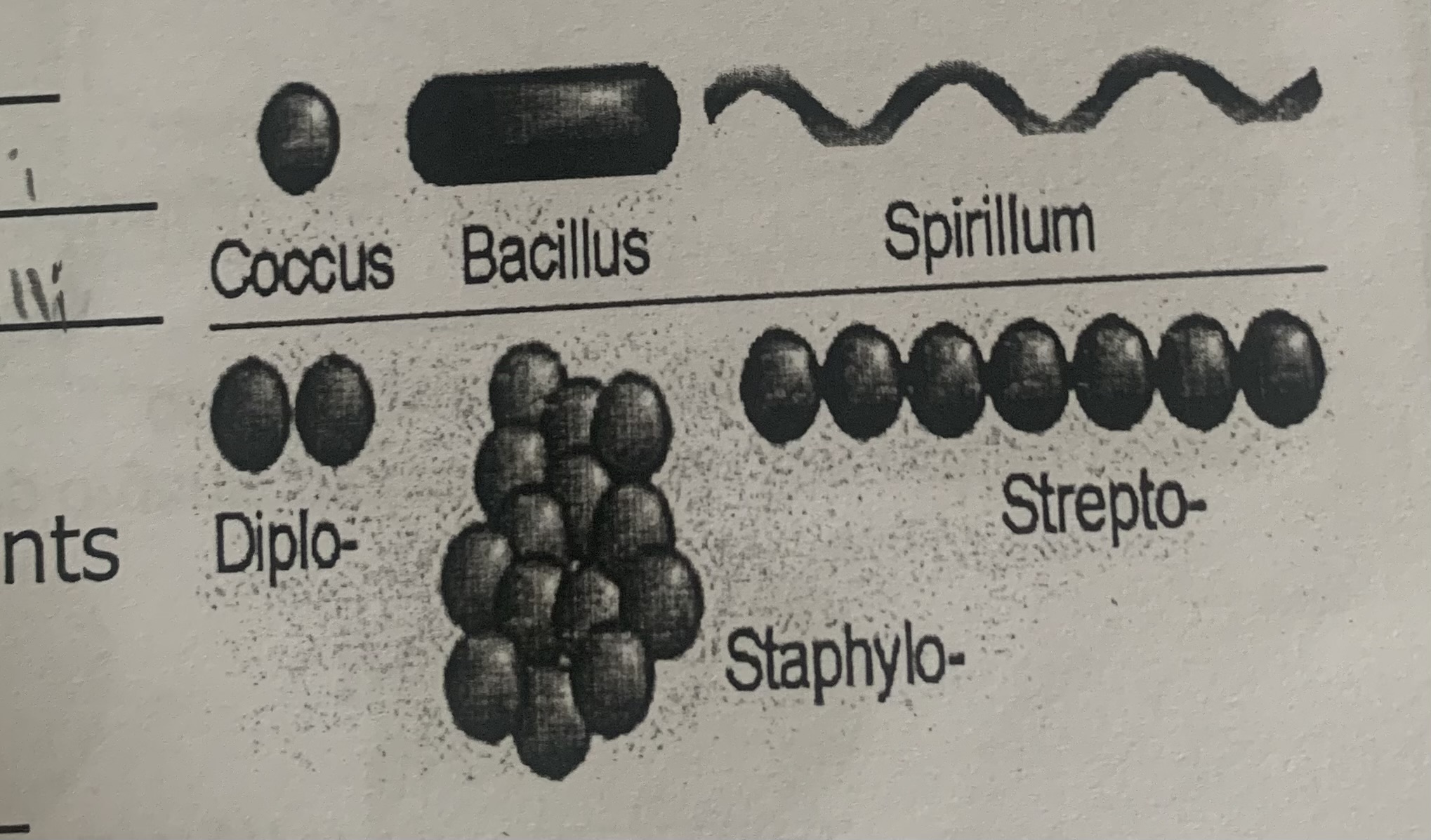
What are tools for motility/movement for bacteria
Flagella → whip-like structures propel bacteria forward
Corkscrew motion → used by spirilli bacteria
Glide on mucous secretions
What are the 5 different categories of characteristics of bacteria?
Cell shape
Motility (method of movement)
Nutritional modes of bacteria
Reproduction
Cell wall structure
What are the different nutritional modes for bacteria?
Heterotrophs → take up organic molecules from the environment or eating other organisms
Photoautotrophs → Use sunlight and carbon dioxide to make carbohydrates (photosynthesis)
Photoheterotrophs → Like heterotrophs, but can also use light energy
Chemoheterotrophs → Use energy generated through chemical reactions involving ammonia, hydrogen sulphide and other similar chemicals
What are the different ways a bacteria can reproduce?
Binary fission
Asexual reproduction
DNA replicates
Cell grows in size
Cell membrane pinches in middle
Two genetically identical daughter cells produced (barring mutations)
Little room for evolution
Average time span: 20 minutes
Conjugation
‘sexual’ reproduction
Bacterial cells temporarily join via a mating bridge to exchange genetic material
Plasmids are exchanged (separates rings of DNA from cell’s main chromosome)
Transformation
Not really a form of reproduction
Bacteria take pieces of DNA from the environment
Useful technique in research to get bacteria (often a strain of E. coli) to mass-produce desired enzymes or compounds)
What are heterotrophs?
bacterias that use the nutritional mode of heterotrophs where they take up organic molecules from the environment or eating other organisms
What are photoautotrophs
bacterias that use the nutritional mode of photoautotrophs is where they use sunlight and carbon dioxide to make carbohydrates (photosynthesis)
What are photoheterotrophs?
bacterias that use the nutritional mode of photoheterotrophs is where they are kind of like both photoautotrophs and heterotrophs, where they are able to take up organic molecules from the environment or eat other organisms and then also use light energy
What are chemoheterotrophs?
bacteria that use the nutritional mode of chemoheterotrophs use energy generated through chemical reactions involving ammonia, hydrogen sulphide and other similar chemicals
How do bacteria reproduce using Binary fission?
Asexual reproduction
DNA replicates
Cell grows in size
Cell membrane pinches in middle
Two genetically identical daughter cells produced (barring mutations)
Little room for evolution
Average time span: 20 minutes

How do bacteria reproduce using conjugation?
‘sexual’ reproduction
Bacterial cells temporarily join via a mating bridge to exchange genetic material
Plasmids are exchanged (seperate rings of DNA from cell’s main chromosome)

How do bacteria reproduce using transformation
Not really a form of reproduction
Bacteria take pieces of DNA from the environment
Useful technique in research to get bacteria (often a strain of E. coli) to mass-produce desired enzymes or compounds
Ex: green fluorescent protein (GFP) gene is transformed into bacteria to be mass produced
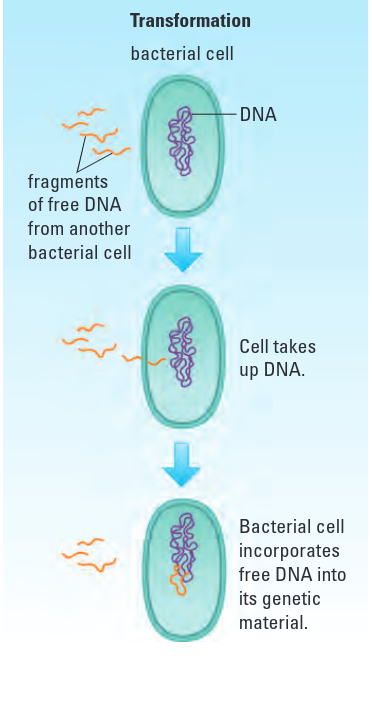
What are the functions of the cell wall of a bacteria?
Provides structure and protection
Maintains shape of cell
Filters certain substances
Contains peptidoglycan
Major component of the cell wall
made of polymers of carbohydrates and amino acids
What are two ways of classifying bacteria according to their cell wall structure?
Gram positive
Thick layer of peptidoglycan
Stain dark blue or violet
Most pathogenic (dangerous) bacteria are gram positive
Gram negative
Thinner layer of peptidoglycan found between outer and inner membrane
Stain pink
Pathogenicity associated with molecules found in outer membrane
Usually more resistant to antibiotics due to their cell wall structure (protected by cell membrane)
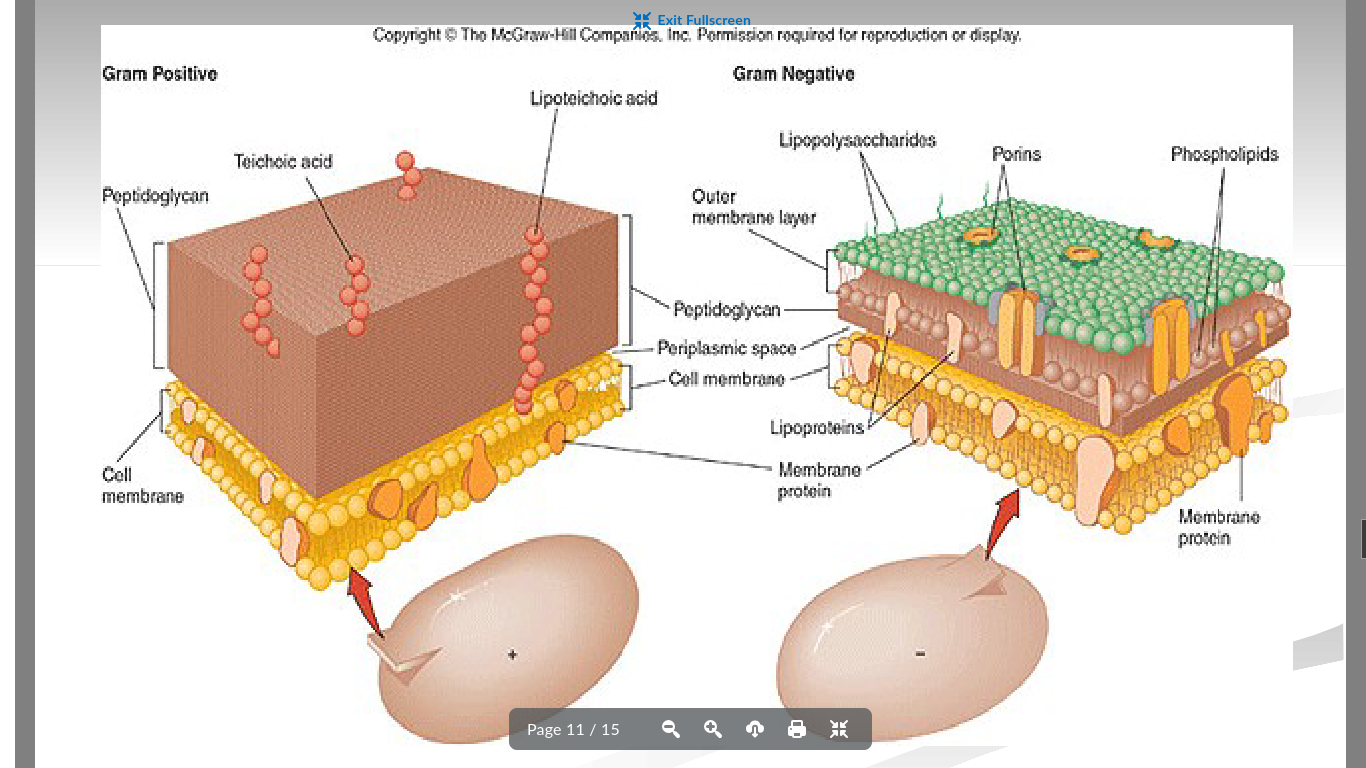
Compare and contrast gram negative and gram positive bacteria
Gram positive
Thick layer of peptidoglycan
Stain dark blue or violet
Most pathogenic (dangerous) bacteria are gram positive
Gram negative
Thinner layer of peptidoglycan found between outer and inner membrane
Stain pink
Pathogenicity associated with molecules found in outer membrane
Usually more resistant to antibiotics due to their cell wall structure (protected by cell membrane)
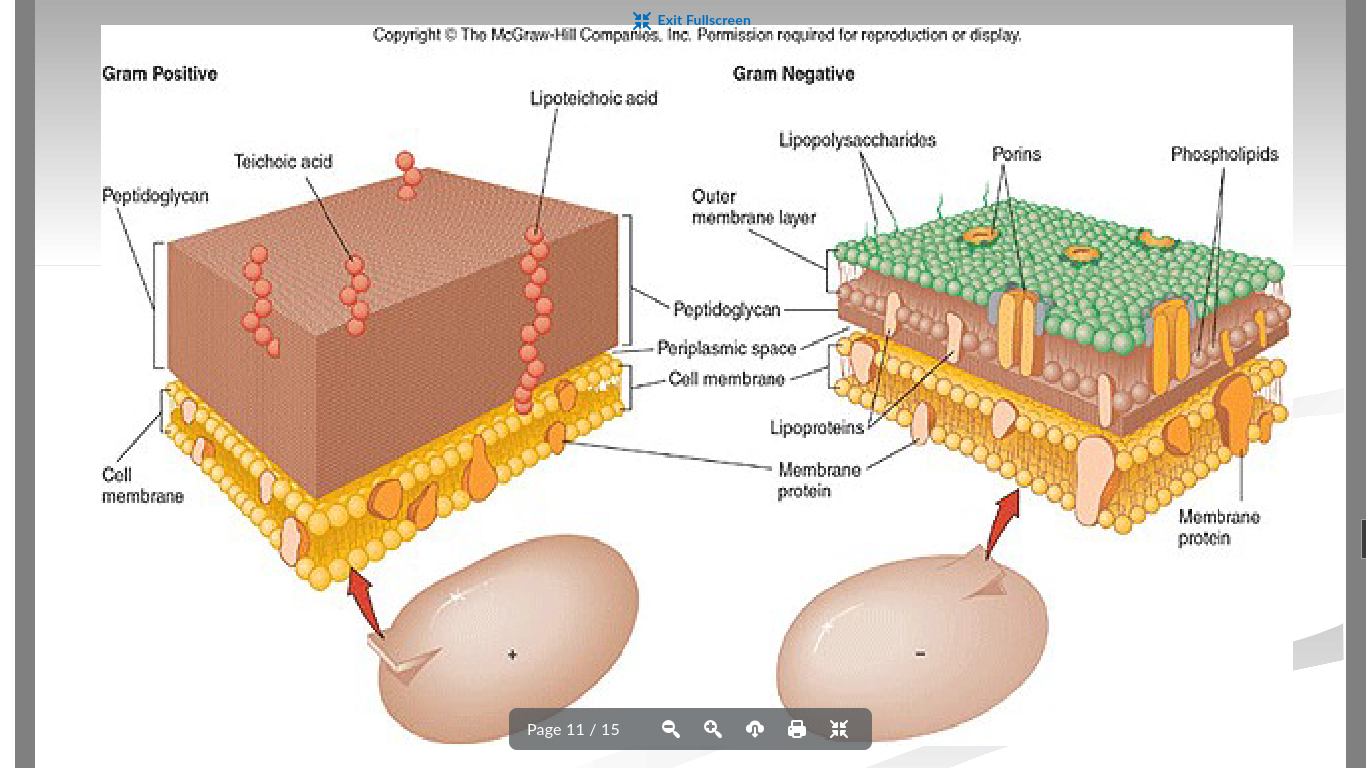
What unique components do antibiotics attack of a bacteria?
Target unique compounds or metabolic processes
Cell wall - very often the peptidoglycan is attacked
Gram negative bacteria usually are more resistant to antibiotics due to their cell wall structure (protected by cell membrane)
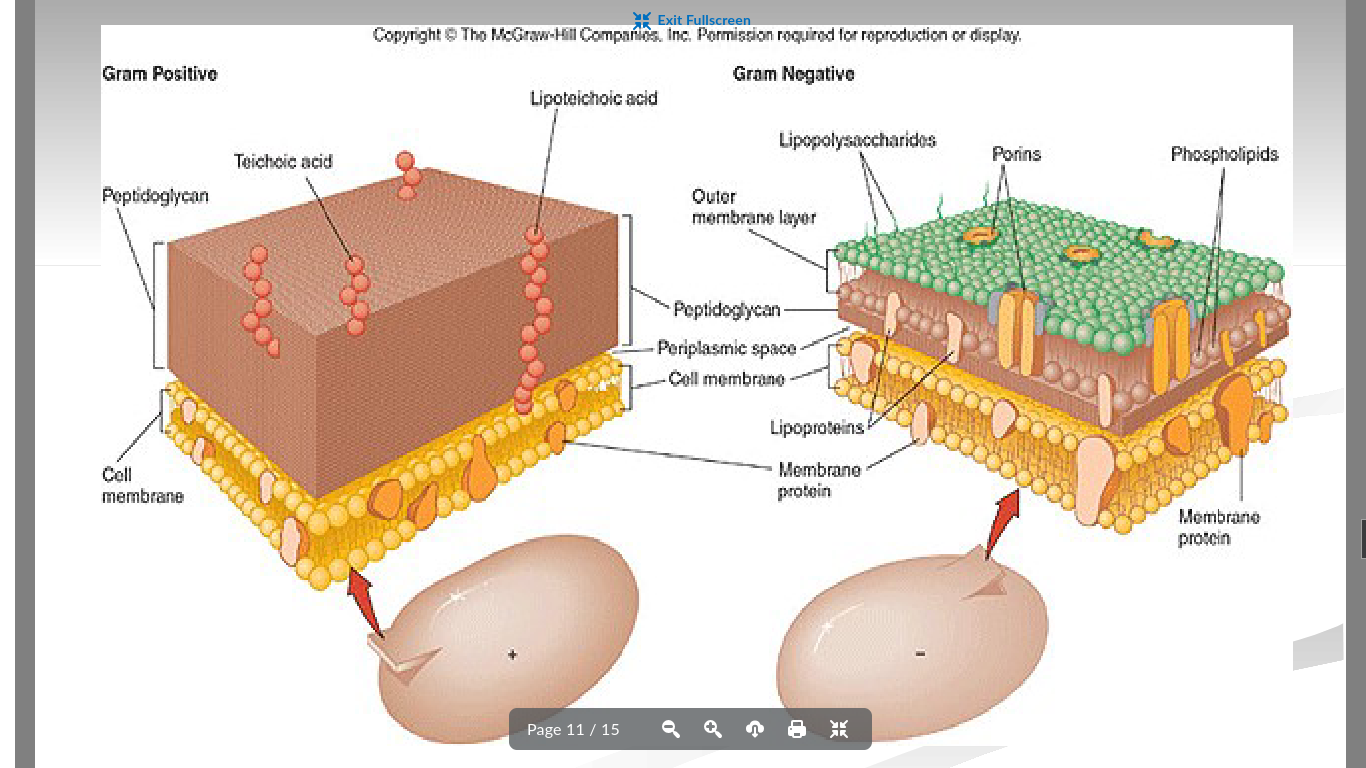
Which bacteria are more resistant to antibiotics: gram negative bacteria or gram positive bacteria
Gram negative are more resistant to antibiotics
Protected more by cell membrane

Identify three differences between archaea and bacteria
Different cell wall structures
Different genetics and biochemistry
Archaeas live in more extreme environments
Describe how prokaryotes are able to move through the environment
Flagella → whip-like structures propel bacteria forward
Corkscrew motion → used by spirilli bacteria
Mucous secretions
What are three major types of morphology found in bacteria?
Named based on variety of shapes:
Spherical → cocci
Rod-shaped → bacilli
Spiral shaped → spirilli
Named based on arrangement of shapes:
Diplo → paired
Staphylo → clusters
Strepto → chains
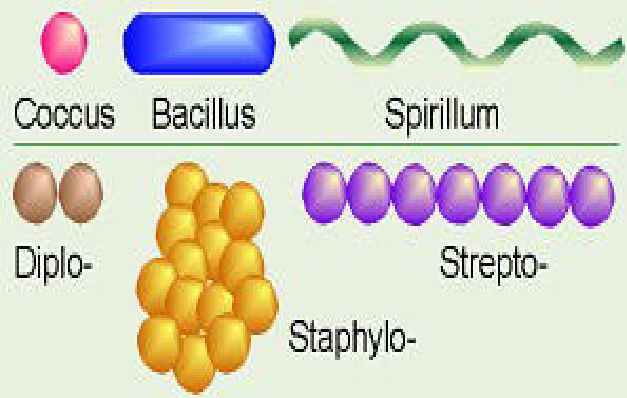
Match the following ways bacteria obtain nutrition with the appropriate nutritional classification: heterotroph, chemoautotroph, photoautotrophs, photoheterotroph
a) Bacteria consuming energy from human tissue
b) Bacteria receiving all their energy from sunlight
c) Bacteria using energy from the sun during the day and then consuming other bacteria during the night
d) Bacteria receiving energy from chemical reactions around a deep sea vent
a) Heterotroph
b) Photoautotroph
c) Photoheterotroph
d) Chemoautotroph
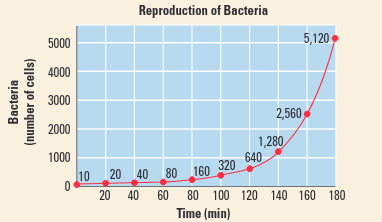
Examine the graph below to answer the following questions
a) How many bacteria were produced during the second hour
b) At this rate, how many bacteria would be present at the end of four hours
c) What type of bacterial reproduction that you read about in this chapter would account for this type of rapid growth
d) If one cell became resistant to an antibiotic due to a mutation at the 80-minute Mark, how many cells would be resistant at the end of the 120-minute mark (assume the same growth rate)
a) 640 bacteria
b) 40960 bacteria
c) binary fission
d) 4 resistant bacteria cells
Explain protists in a nutshell
Domain → Eukarya
Kingdom → Protista
Category for the ‘uncategorizable’
Any eukaryotic organisms that is not an animal, plant, or fungus is a protist
What are general characteristics of protists?
Typical eukaryotic cell structure
Most are unicellular or form colonies
Some multicellular protists exist (kelp is considered a protist)
Explain the different ways of movement in protists
Stream cytoplasm into extensions called pseudopodia
Ex: Amoebas creep slowly in a direction using their pseudopodia
Use of flagella and cilia (much shorter than flagella and all around cell membrane)
Ex: zoogflagellates are heterotrophic protists that have one or two flagella
Reliance on water, currents, wind and host animals
Ex: Apicomplexa release spores that can grow inside organisms as parasites

How do protists reproduce?
Protists like amoebas, paramecia and most ciliates reproduce through a process similar to binary fission
Paramecia can also exchange genetic material with each other through conjugation (though this doesn’t produce offspring)
Many protists alternate between sexual and asexual reproduction
Slime moulds and plasmodium (causes malaria) undergo reproduction as shown

What are the types of protists?
Animal-like protists
Also known as Protozoa
Heterotrophic
Four different phyla, based on motility:
Amoeboids
Flagellates
Ciliates
Apicomplexa
Plant-like protists
Also known as Algae
Photosynthetic
Contain chloroplasts
Can be unicellular, form colonies and multicellular
Six types:
Dinoflagellates (possess flagella and a cell wall made of cellulose)
Red algae
Brown algae
Green algae
Diatoms
Euglenoids (no cell wall but can undergo photosynthesis)
Fungi-like protists
Heterotrophic (feed on decaying organic matter)
Also referred to as decomposers
Unlike fungi, most are unicellular but form colonies
Form spores
Reproductive cells that enter the bodies of other organisms and live as parasites
Two main types:
Slime mould (branching protist found on decaying matter)
Water mould (decompose dead matter in freshwater habitats)
What are animal-like protists?
Common name → protozoa
They are heterotrophic (capture and ingest food
Four different phyla, based on motility:
Amoeboids
Flagellates
Ciliates
Apicomplexa
What are the four different phyla of animal-like protists?
Four different phyla, based on motility:
Amoeboids
Flagellates
Ciliates
Apicomplexa
What are plant-like protists?
common name → algae
Photosynthetic (create food using light)
Contain chloroplasts
Can be unicellular, form colonies, and multicellular
Six types:
Dinoflagellates (possess flagella and a cell wall made of cellulose)
Red algae
Brown algae
Green algae
Diatoms
Euglenoids (no cell wall but can undergo photosynthesis)
What are the six types of plant-like protists?
Six types:
Dinoflagellates (possess flagella and a cell wall made of cellulose)
Red algae
Brown algae
Green algae
Diatoms
Euglenoids (no cell wall but can undergo photosynthesis)
What are fungi-like protists?
Common names → Slime mould or water mould
Heterotrophic (feed on decaying matter)
Also referred to as decomposers
Unlike fungi, most are unicellular but form colonies
Form spores
Reproductive cells that enter the bodies of other organisms and live as parasites
Two main types:
Slime mould → branching protist found on decaying matter
Water mould →decompose dead matter in freshwater habitats
What are the two main types of fungi-like protists
Two main types:
Slime mould → branching protist found on decaying matter
Water mould →decompose dead matter in freshwater habitats
Explain why an amoeba and paramecium are considered “animal-like” protists
Because they are heterotrophs and surround prey to digest
Identify the organism that causes malaria and describe its life cycle
Carried in mosquitos that are infected with Plasmodium
A mosquito infected with Plasmodium bites a human
Plasmodium infects human liver cells, which eventually burst, releasing a different form of protist
Plasmodium infects red blood cells and divide asexually. The red blood cells burst and release more plasmodium cells
Another mosquito bites the infected person and picks up plasmodium cells
Plasmodium reproduces sexually in the mosquito
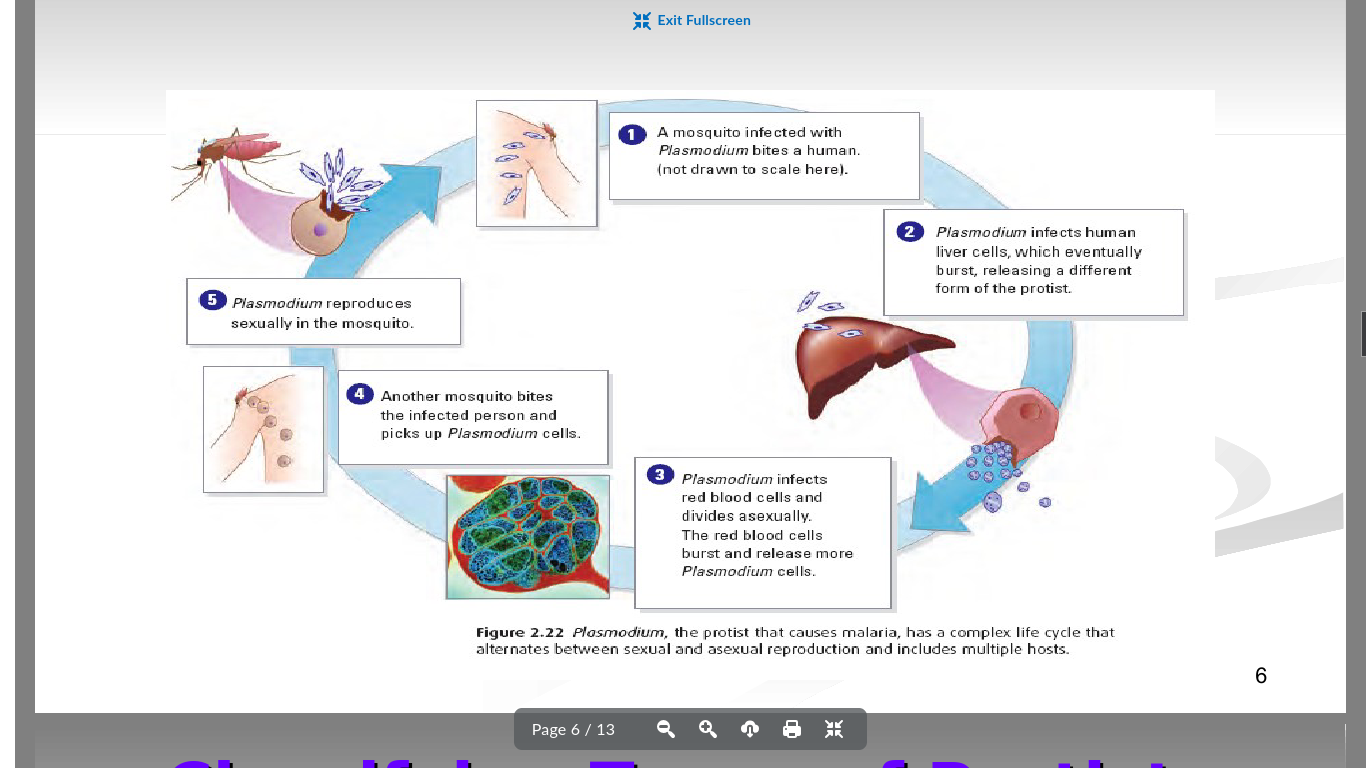
What characteristic do all protists have in common?
They are all eukaryotic
Contrast three models of movement among protists
Pseudopodice → streaming cytoplasm into extensions that creep and stretch slowly in a certain direction using their pseudopodia
Flagella and cilia → using their flagella and cilia to move around
Reliance on water, currents, wind and host animals

Use the photograph to answer the following questions
a) Explain how the organism in the photograph obtains food
b) Based on this organism’s mode of nutrition, what group of protists would you classify it in
a) The photo shows an amoeba
Amoebas slowly engulfs food with pseudopodia, where they surround their prey/food , forms an internal food vacuole, or cavity, that digests the food
b) Animal-like protist and heterotroph as they capture food and ingest food
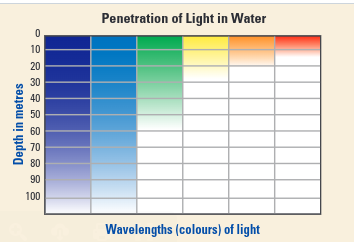
The graph indicates the depth that certain wavelengths (Colours) of light penetrate water.
a) Which Colours of light are available for photosynthesis by algae that live at a depth of 10m? 70m?
b) Some algae grow best when both blue, violet, and red light are available for photosynthesis. At what depth range would you expect to find this algae
c) Red algae can grow at depths of 100m or more. What can you infer about the type of red light algae can use for photosynthesis? Explain
a) 10m → violet, blue, green, yellow, orange, and red
70m → violet and blue
b) Up to 10m of depth
c) Red algae doesn’t use red light for photosynthesis, but instead reflects it so we see red
What characteristics of Euglena make it challenging to classify?
Euglena has no cell wall, so that made it challenging to classify, however, undergoes photosynthesis so most biologists classify them with algae (plant-like protists)

Explain fungi in a nutshell
Domain → Eukarya
Kingdom → fungi
More closely related to animals than plants
What are general characteristics of fungi
Heterotrophic → no photosynthesis
Decomposers → use powerful enzymes to break down organic matter into nutrients that they absorb
Food sources include fallen logs, dead animals, wastes of living things
Also important in recycling nutrients like nitrogen and carbon into the soil
Some fungi live as parasites → absorbs nutrients from cells or body fluids of living hosts, damaging the organism
Ex: Blight, corn smut, athlete’s foot
Fungi cells are eukaryotic
Contain cell walls made of chitin (a strong carbohydrate polymer
Yeasts are a group of unicellular fungi, but most are multicellular
Most can reproduce both asexually and sexually
What are the primary structures of fungi?
Hyphae (singular → hypha)
Many cells surrounded by a single cell wall to form long fibres
Cell walls in hyphae contain structures called cross-walls that divide cells; porous to allow cytoplasm and nutrients to be evenly distributed through the fungus
Mycelium
Underground network of hyphae
Fruiting body
Usually the visible part of the fungus above the ground
Reproductive structure
Produces spores
Mycorrhizae
Vast networks of mycelia that forms a mutualistic relationship with plant roots
Receives sugars, starches, proteins, lipids from plant roots
Acts like an extension of plant roots and help the plant collect nutrients like water and phosphorus
Small size allows the mycelia to penetrate into spots that plant roots cannot
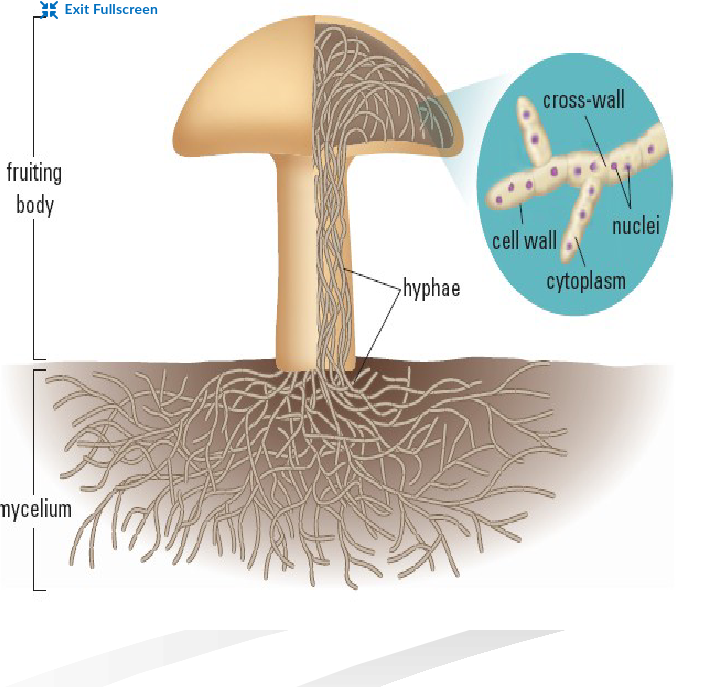
What are the two ways fungi can reproduce asexually?
Budding
Small piece of hyphae breaks off and becomes a separate organism
Spores
Haploid cells (n) → each spore cell contains a single cet of chromosomes (46)
Reproductive cells spread by the wind and can germinate (grow) under favourable conditions
How can fungi reproduce sexually?
Fungi have two different sexes:
+
-
Opposite haploid (n) hyphae grow towards each other and fuse to form a diploid (2n) zygospore
Zygosphore has two sets of chromosomes from each parent hyphae
Produces haploid spores that are genetically unique
Increases genetic diversity; allows for adaptation to changing environment
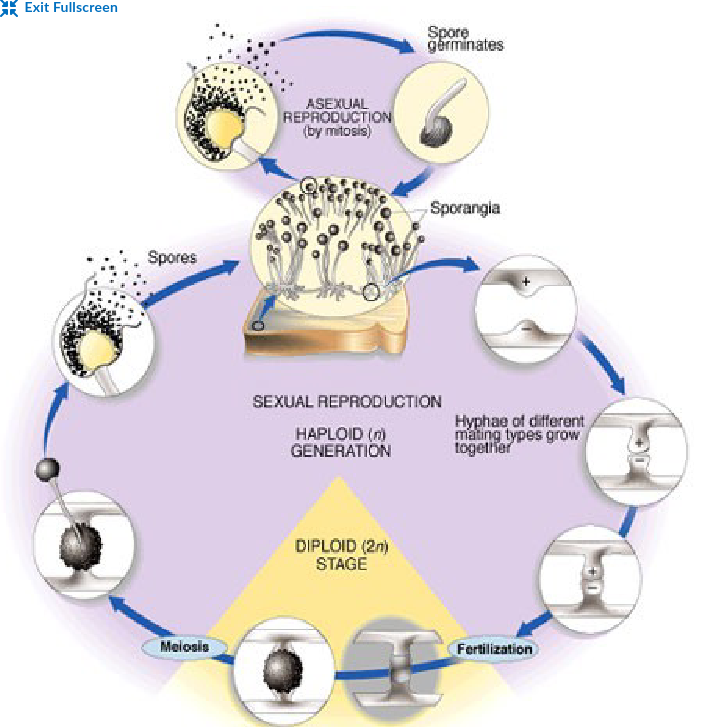
What are the main phylas of fungi?
Different phyla of fungi classified primarily based on reproductive structures
Chytridiomycota (chytrids)
Spores are flagellated and motile
Ex: chytrids (parasites on amphibians)
Zygomycota (common moulds)
Produce zygosphores which are highly resistant to environmental conditions
Ex: bread mould
Ascomycota (sac fungi)
sacs called asci contain spores
Sacs found on top of fruiting body
Ex: Yeast, truffles, morels
Basidiomycota (club fungi)
Contain club-shaped cells called basidia that contain spores
Basidia found under fruiting body
Ex: mushrooms
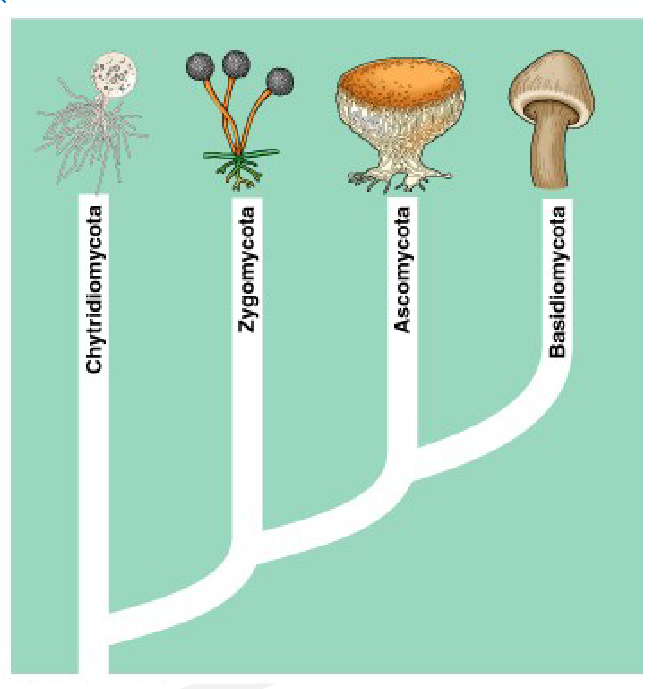
What characteristics define fungi?
heterotrophic
Decomposers
Some are parasitic
Eukaryotic
Most multicellular
Most produce asexually and sexually
How are yeasts different from other fungi?
Unlike most fungi, yeasts are unicellular
What features of a mycelium make it an efficient structure to obtain food from absorption?
Mycelium covers a large surface area, so it absorbs a lot of nutrients
What is the purpose of hyphae?
Hyphae → long, thread-like fibres that make up fungi
State the function of fungal spores
Spores → reproductive cells of a fungus that help with reproduction
Create a flowchart that describes the reproductive cycle of a typical fungus, such as bread mould

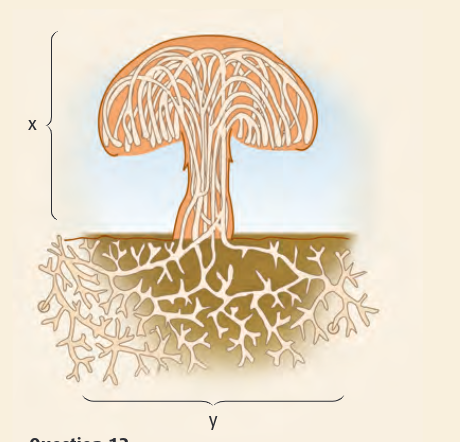
The diagram shows a cross-section of a fungus
a) What is the name of structure “x”? Describe its function
b)What is the name of structure “y”? Describe its function
c) What information would you need to classify this fungus into its correct group
a) x →fruiting body → reproductive structure and produces spores
b) y→ Mycelium → underground network of hyphae + absorbs food/nutrients underground
c) idk

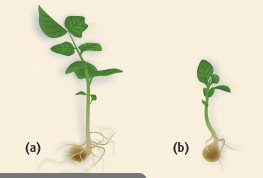
The picture shows the results of an experiment performed on pea plants. Plant (a) has been grown in a soil mixture rich with mycorrhizae fungi. Plant (b) has been grown without the benefit of mycorrhizae. Explain why there is a difference in the two plant root system
Mycorrhizae has more hyphae that dig deeper and grab extra nutrients
Name 6/7 unique characteristics of all prokaryotes
No nucleus
No membrane bound organelles
free-floating enzymes
unicellular
small/microscopic
cell walls
asexual reproduction
What are major differences between the archaea and bacteria kingdoms?
Archaea live in extreme environments
Diff cell walls
Different genetics and biochemistry (archaea closer to eukaryotes)
Any disease-causing agent is known as a ________
pathogen
Name the types of habitats the different type of Achaea live in:
Halophile
Thermophile
Alkaliphile
Acidophile
Halophile → high salt env
Thermophile → high temp env
Alkaliphiles → very basic env (high pH)
Acidophile → very acidic env (low pH)
E. coli O157:H7 is primarily transmitted to humans via consuming __________
Undercooked beef
Rod-shaped bacteria that arrange themselves in straight chains can be referred to as:
streptobacilli
Strepto → arrangement
Bacilli → cell shape
The three methods of motility for bacteria include:
Mucous
Flagella
Corkscrew motion
Name the description for each bacteria on how they obtain energy:
Heterotroph
Photoautotroph
Photoheterotroph
Chemoautotroph
Heterotroph → consume nutrients
Photoautotroph → energy via light (photosynthesis
Photoheterotroph → energy via light and consuming nutrients
Chemoautotroph → derive energy from inorganic chemicals
Bacteria can reproduce asexually using a process called ________
binary fission
In conjugation, no _________ is produced; there is only an exchange of genetic material between two bacterial cells
Offspring
The ‘structure’ that is created between two bacterial cells that allows for genetic exchange is called a _______________
mating bridge
The unique components of bacterial cell walls is called ____________
Peptidoglycan
Compare the two types of bacterial cell walls:
Gram positive
Gram negative
Gram positive
Thick layer of peptidoglycan
more pathogenic
Stain dark blue/ violet
Gram negative
Thin layer of peptidoglycan
Stain pink
More resistant to antibiotics
The three methods of motility for protists include:
pseudopodia
flagella and cilia
wind, water, animals
Using these type of protists, give the common names, a unique trait, and an example of a representative organism
Animal-like protist
Plant-like protist
Fungi-like protist
Animal-like protist
Common name → protozoa
Unique trait → heterotrophic
Ex: amoeba
Plant-like protist
Common name → algae
Unique trait → photosynthetic
Ex: kelp and algae
Fungi-like protist
Common name →slime moulds
Unique trait → decomposers
Ex: slime moulds or water moulds
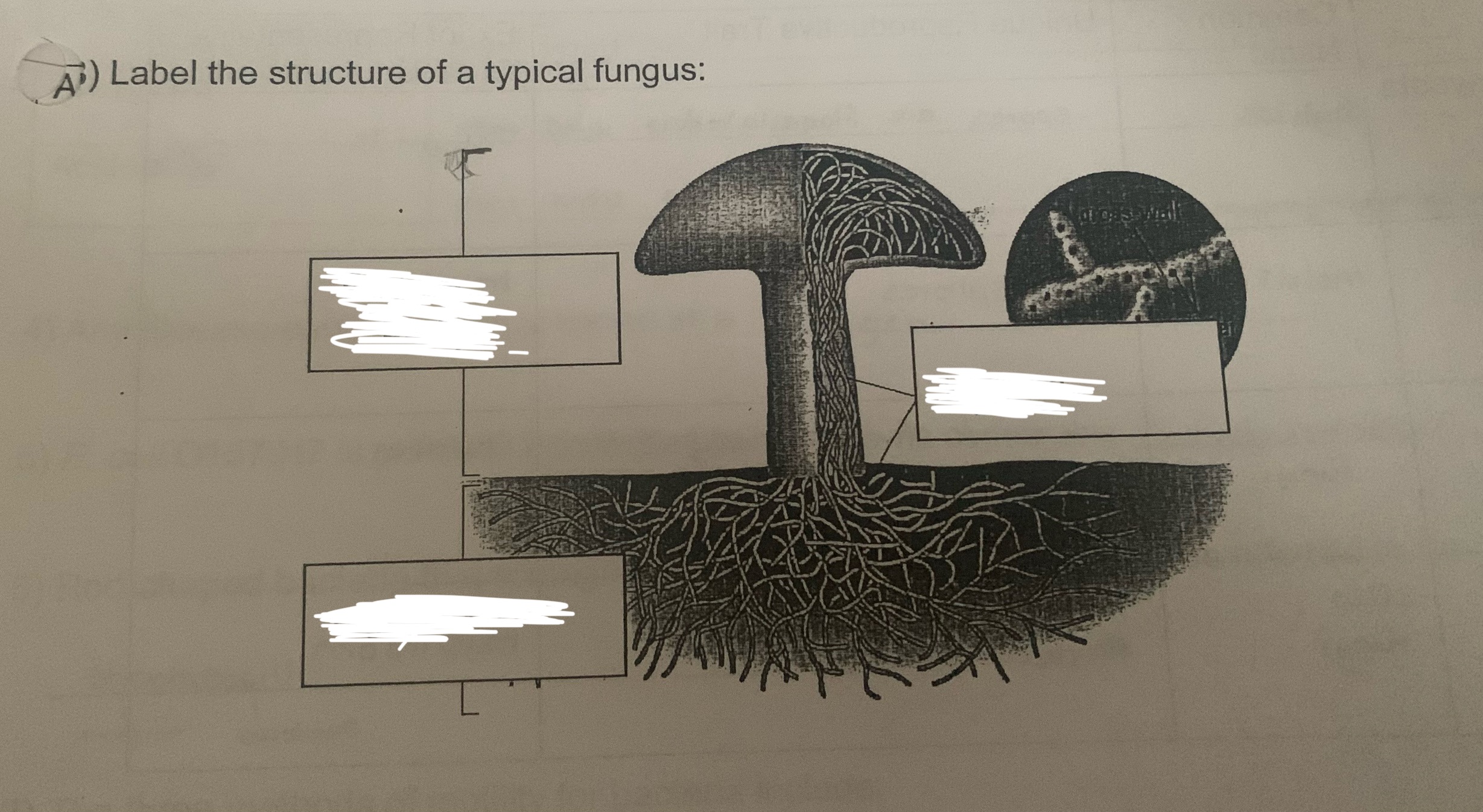
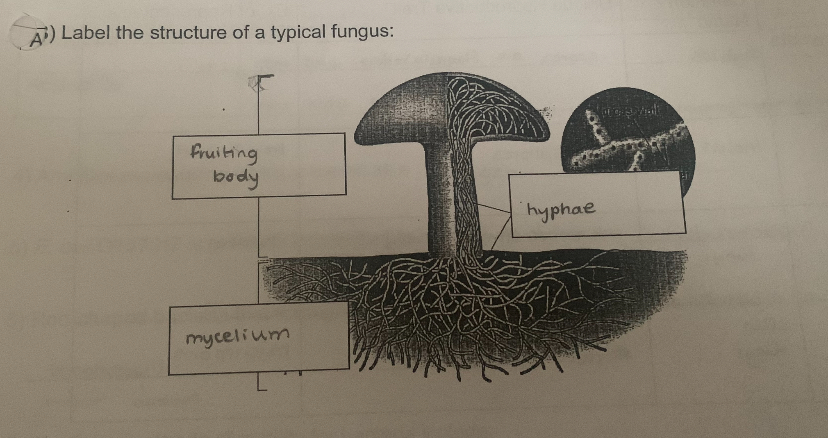
Fungi break down and consume dead organic matter, making them _________
decomposers
Fungi have a unique component in their cell walls called _________
chitin
The two methods of asexual reproduction in fungi include:
Releasing spores
budding
Draw a simple diagram showing sexual reproduction in fungi
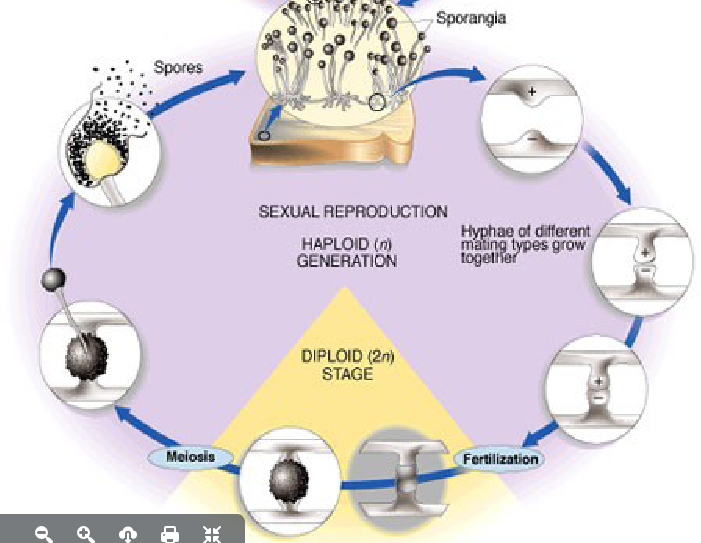
Using the different four phyla of fungi, give its common name, its unique reproductive trait and a representative organism
Chytridiomycota
Zygomycota
Ascomycota
Basidiomycota
Chytridiomycota
Common name → chytrids
Unique reproductive trait → spores are flagellated
Ex: chytrids
Zygomycota
Common name → molds
Unique reproductive trait → zygosphores
ex: bread mold
Ascomycota
Common name → sac fungi
Unique reproductive trait → inverted fruiting body (asci)
Ex: truffles
Basidiomycota
Common name → club fungi
Unique reproductive trait →contain basidia that produces spores
ex: mushroom